Blog home / Summer in Mongolia: travelling among nomads
Like the soft glow of predawn light seeping through the thin fabric of my tent, melancholic cries of a camel bleed into my dreams.
It is seconds before I’m up and out of the sleeping bag, preparing to peel back the door, camera in hand. I savour this moment of anticipation every morning in Western Mongolia where an ever-shifting narrative in the landscape doesn’t stop when the sun goes down.
I crack open the zip.
A-framed from the tent, clouds of the night is retreating to the upper valley into the highest mountain abodes. Muscular clumps of grey curl and twist, snagging on spires of rock, casting marbly shadows across ribbed glacial ice. The sky above camp is the palest of blues, washed clean by a hint of rain and snow. As the land holds its breath, the last stars blink out.
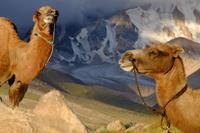
In much of the western world, we associate grand mountains like these with wilderness, where humans venture only temporarily. But here, in the Altai Mountains — home to a cradle of ancient nomad civilisation — there are constant reminders that the continuum of human life on the land has never been broken.
It’s not long before a herder’s cry cuts through the air. In the middle distance come our dozen-strong herd of Bactrian camels. They seem to bob and sway with the same prehistoric grandeur of the serpentine glaciers beyond.
Bringing up the rear on foot in their colourful multipurpose cloaks, known as deels, are our three herders: Miyaga, Basenjav, and Tsagana. They’ve spent the night under the stars and have already been up for a couple of hours, climbing to a high shelf to fetch down the animals. They later tell me with cheer that there were wolves during the night on the far side of the valley. In Mongolia, where the wolf is both venerated and feared, seeing a wolf is a sign of fortune.
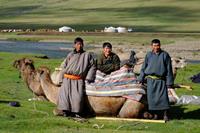
As I prepare my camera I mull over the many times in the past decade that I’ve watched these same herders make the most incredible feats look routine — at first during my own adventures, and subsequently as a guide.
There was the night, for instance, when, in the shadow of an approaching storm, they led their horses and string of camels packed to the hilt down sheer, rocky slopes with nothing but a hint of starlight.
Another time, when the temperature dropped to the minus twenties, they sandwiched themselves between a couple of felt camel pads on the frozen ground. The offer of a tent and a sleeping bag is routinely brushed away with a grin — when on the move it is essential for them to be outside, in tune with their environment, to ensure the safety of their animals. Besides, the really hard times transpire in the winter — seldom witnessed by outsiders — when the temperature can drop to minus sixty degrees.
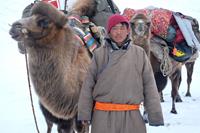
With little more than a couple of inches of tent felt and dung fire for warmth, it is during those times they must contend against the threat of blizzards; wolves, which hunt in packs in the winter; and even snow leopards. Protecting one’s animals and finding enough feed requires untold millennia of accumulated knowledge and a large pinch of resilience.
For the time being, it is mid-June and the perils of winter couldn’t be further from the mind. The herders, together with their horses and camels, have taken two weeks of leave from their families, who are lower down in the valley, to travel with us for the mountain crossing.
As the first rays of light rain down, the sun’s warming effect is immediate. Frost encrusted alpine grass and flowers spring back to life, and the iced up double humps of the camels are rendered wet and shiny. For these nomads, and us trekkers alike, it is the dawn of another idyllic summer’s day.
Migration day
As a nation perched on a high plateau between China and Siberia, Mongolia’s nomadic life is arguably akin to threading the eye of nature’s needle. Survival depends on successfully seeking out the elusive shelter, grass and water that nature affords. It’s a cyclical way of life tied to seasons which date back to more than 5,000 years when horses were domesticated.
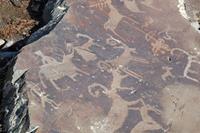
Today, around 30 percent of Mongolians are still nomadic, many of whom continue to buck the trappings of the modern world, adapting their lives to the fragile ecology of the steppe and only owning as many possessions that fit on the back of their camels.
I return to Mongolia every year driven by a yearning to understand and experience nomad life, and there is perhaps no better expression of nomadism than migration day.
More than just a ritualistic move from one camp to another, migration day is a chance to celebrate the changing season, honour the ancestors, and parade one’s family and animals — the measure of wealth and vitality in traditional steppe society.
RELATED: Top treks in Mongolia
We’ve barely laced up our trekking boots when a symphonic clatter of hoof-on-earth carries on the morning breeze. A few hesitant sheep, goats and yaks trickle over the rise, which soon becomes a surging tide as hundreds of animals stampede.
Driving them forward is a boy no older than ten, and his even younger sister — both dwarfed by their Mongolian mounts, but sitting straight-backed and proud like grown adults. Their cheeks, broad and chapped red, tell a story of colder and harder times.
Beyond them, a camel caravan materialises weaving through a messy moraine shelf. Each animal carries segments of the collapsible walls, ceiling, and felt insulation of the traditional ger (also known as a yurt), but also the odd upended tea table, beds, solar panels and car battery.
Guiding the camels is a young lady in silky blue riding a sturdy steed on a horn-embellished saddle. We meet her as she and her husband drop anchor at a recently established summer encampment.
“Good migrating to you!” cries an old lady emerging from the ger.
“Good summer place staying to you,” replies the young lady, dismounting.
In nomad societies, it is taboo to allow migrating families to pass without an offer of hospitality. Milky tea, dried curd, yoghurt, and deep-fried dough is soon brought out by the bowlful like clockwork — in some cases handed up to the youngest occupants still atop the camels.
The young lady waves us over to where she is busily untying something from the kneeling lead camel. There, wrapped up and protected by sheepskin in a basket is her baby. There are many fleeting moments that I will take with me from this day, but it is the picture of her, her baby and camel that etches in my memory above all. It is a reminder that these people live on such close terms with their animals — and through their animals with the subtleties of the land — where they put more trust in them with their precious loved ones that we might in our society with fellow human beings.
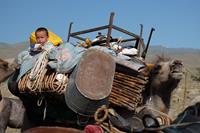
Hospitality as the linchpin of life on the steppe
It’s a different day and a different mountain. I am head down, pushing through boggy alpine pastures underlined with permafrost. A few hours ago, I was standing with my group on a ridge at nearly 4,000 metres gazing over plains, desert and snow fluted peaks — a fence-free vista dotted with the occasional speck of white (a nomad ger) which define the Mongolian landscape.
But now, after a long hard trek down the edge of a glacier, I’m weary, hungry, and the weather is coming in. With just half a kilometre to camp, the rain and hail hit like a train. It’s only then that I lift my eyes to a nomad ger a stone’s throw away. I call to the trekkers ahead of me, but the deafening sound of rain is all too much.
The outside world vanishes as the door closes behind me. There is no tradition of knocking amongst nomads, and the lady cooking tea over her dung fire simply ushers me to a stool:
“Drink tea! How is your journey? How is your summer?”
The stillness hits me first. Then the heat causes the skin on my cheeks and fingertips to tingle. Beyond the felt-insulated walls, the driving rain is all but a soft, calming patter.
Details come to life slowly in the dim interior. Above me, long fatty strips of mutton known as borts seem to emerge, hanging from the ceiling. These will eventually be crushed into a powder for easy storing and travel — hence the old saying that horseback warriors could carry a ‘sheep in their pocket.’
At the back of the ger stands a table of family portraits, horse race medals, and a calendar replete with Mongolian wrestling champions. Lastly, on the opposite spring bed under a pile of rugs and cloaks, I notice two sets of eyes: the host’s young daughter and son.
The door opens again and it spills a wiry bow-legged man, wet to the skin — his horse hastily tied up outside. He is a Kazakh nomad out searching for a lost herd of horses.
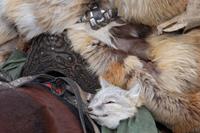
For the next half hour, we wait out the storm, drink tea, and talk — the kind of time out that nature sometimes affords. I can’t help but imagine that it is a scene of open hospitality that could have played out at any time in the past few millennia.
Traditionally, there was even a rule that for the first three days, the host was forbidden to ask what the nature of the business was of the guest, who they were, or even where they were going. The obligation is to offer food, water and shelter — a gesture that, in the lifetime of any host will no doubt be repaid in kind. I wonder whether it is a tradition that will endure for another millennium.
RELATED: Disconnect to Reconnect: Take a Tech-Free Holiday
As the world changes, Mongolia has so far remained a place where private land is restricted to towns and cities — a fundamental law written into the constitution which allows nomad life to exist for now, but for how long? It’s anyone’s guess. The unfolding narrative of nomad society here is not as simple as some might imagine. But it is another very complicated story for another time.
The rain stops, the sun breaks through the gaps around the flue, and the working day resumes. The Kazakh man remounts and the children emerge to bring in the goats for milking. I too am about to go to camp where my trekkers might be beginning to wonder when the lady stops me.
“I’m wondering if you have a doctor in your group? My son fell off a horse and broke his arm a week ago.”
The boy, not as timid as before but still nervous rolls back his sleeve to reveal a splint of cardboard. The mother tells me that her husband is away cutting grass for winter in their autumn stopping place so she hasn’t been able to leave her livestock to seek help. The boy, who is ten years of age, holds back tears as I cradle it. The break is serious — in fact, later in the evening, when I return with one of the medically-trained trekkers, we will remove the splint and discover that his wrist is broken right through and urgently requires surgery.
The boy has had no access to painkillers, not even paracetamol, and the nearest hospital is six to eight hours by four-wheel drive or two to three days by horse. Like the winters these people face, the sheer minimal possessions they own, what this boy has been through, the bravery he has shown is beyond comprehension.
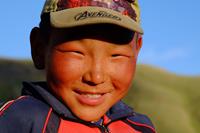
I think back to when I was ten — it was, somewhat coincidentally the year I was thrown off a horse at home and broke my own arm. It had been painful, but I’d been bundled into a car and taken to hospital in less than an hour. There had been tears, and for the next 20 years I had been too scared to climb back on a horse.
It draws a line under the gulf between my upbringing and his. At age ten, this boy is already largely responsible for herding the animals high into the mountains each day to find pasture that will see them through the winter. In a single day he may need to scare away wolves, endure rain, and snow, and navigate off track in mountains bareback on a horse — and that’s before milking the goats and yaks. This boy, even with a broken arm, for the last seven days in the absence of his father has taken on more responsibility than some of us might in our entire lives.
All I can do for the time being is offer a better splint and some basic painkillers.
Later that night, among the trekkers, we decide to pool our money to pay for a four-wheel drive to get the boy to hospital for surgery. I can’t imagine the pain he will be in as the vehicle sways and grunts its way out of the mountains — a traumatic experience for the healthiest of passengers.
When we give the money to the mother in the morning, the boy comes out grinning from ear to ear, handing me a bag of dried curd in return.
I’ve wondered ever since how he is. I do not even know his name. But next trekking season when we are in the mountains I hope to find out.
Words and photos by Tim Cope.
Have you travelled to Mongolia? Share your experiences in the comments below.
Want to experience the culture and nomadic life of Mongolia? Walk among nomads with Tim Cope on his various Mongolia trekking tours.